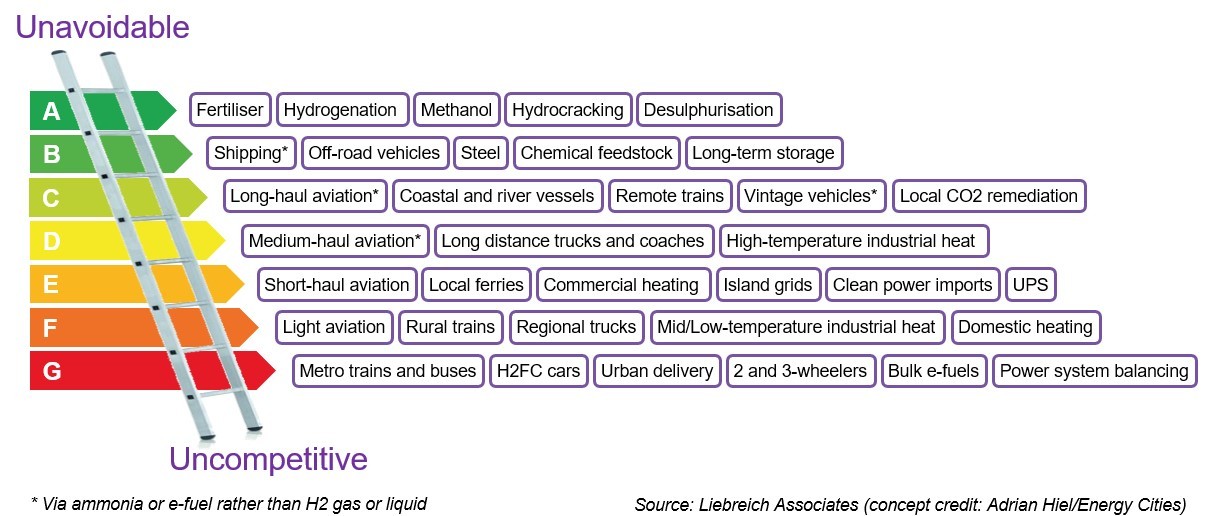My worry is that demand for hydrogen will be too high for green hydrogen to supply and we'll be stuck with lots of gray hydrogen for a long time to come. We need alot of hydrogen already for non-energy uses, ammonia, steel, petrochemical of all sorts. I am actually opposed to using hydrogen in ground transportation because it will require decades to build up a big enough electrolyzer fleet to supply displace all the hydrogen now produced from gas and coal.
Additionally, I view the round trip efficiency of hydrogen as a red herring. As long as there is not enough hydrogen to eliminate gray hydrogen, it is perfectly fine to source natural gas to backup power grids. That is, what is the logic of generating hydrogen from so that you can use hydrogen to backup the grid? The only rationale I know of is so called blue hydrogen, which is gray hydrogen plus CCS to limit emissions. So in theory if you use blur hydrogen to generate power that is comparable to using natural gas plus CCS to generate power. CCS, of course, will always be an incremental cost and energy waste when added to either a hydrogen or power generation plant. So I'm very skeptical that the economics will ever workout well for CCS.
So my outlook is that even if all the power grids of the world were to generate enough hydrogen to do seasonal grid balancing, the globe would still need places like Australia and the Middle East to export green hydrogen, and that still would not be enough to eliminate gray hydrogen. I am not opposed to using massive battery and hydro storage to balance a grid. I am optimistic that battery costs can continue to decline quite a bit. I am also optimistic that the cost of electrolyzers can decline quite a bit as well. It just turns out that when an electrolyzer is optimized for maximum return, it draws power only when it is marginally profitable to do so. This is important to keep in mind when building out an agent based model. When the power price goes above the marginal breakeven, typically between $20 and $30 per MWh, generation shuts off. Battery storage is unlikely to discharge until the price exceeds a higher threshold. So microeconomics of electrolyzers is that they compete with batteries for cheap power to charge on and do not create demand for the discharge from batteries. This microeconomic interplay means that electrlyzers will undermine the fragile economics of low frequency storage. When you do your agent-based modeling, I think you'll see this play out.
Another thing you may find is that the as a grid is dominated by zero-marginal generation with sufficient storage, you no longer have fuel-based generation setting or dominating the price for generation. So if generation is only weakly determining the market price for power, what is? I believe marginal industrial-scale consumers like electrolyzers will be really key in determining and stabilizing the wholesale price of power. Batteries a great as market makers as they switch from charge to discharge to take advantage of price volatility, but they are not so good when there is a surplus of RE generation. In your charts there are many hours where SoC is near 100%. Near 100%, batteries will find very little price spread to trade on. If you were modeling power prices, you'd find that the price of power is nearly zero. This means that your batteries and all generation capacity are producing almost no economic value at all when the market is oversupplied and SoC is nearly at 100%. But if you've got even a small electrolyer fleet, they can feast off of these low power prices. Indeed suppose the marginal breakeven price for electrolyzers is $30/MWh, then they are when RE is in surplus to what even the batteries need to charge on, they are enjoying a surplus profit of nearly $30/MWh just to be running. This bigger this surplus profit is over the course of the year, the more eagerly investors will add capacity to the fleet. Basic microeconomics anticipates that the electrlyzer fleet will grow, bidding up the price of cheap power, until some equilibrium is reached. At this equilibrium, electrlyzers set the prices at which batteries charge. The spread from the average discharge price for batteries to average charge price will determine the economic value of battery capacity. If the battery fleet is too small, this average spread will be high, and investors will add more capacity. Thus, the battery fleet grows to some equilibrium. If you do agent-based modeling, on the choice to added more battery or more electrolyzer capacity to the market, you'll see this dynamic play out.
There is a market equilibrium between electrolyzer and battery capacity such that it is unprofitable to add one more unit of either to the market. At this point, if marginal wind or solar have low enough LCOE below the marginally profitable power price for electrlyzers, then that unit of wind or solar will find adequate demand. So basically, wind and solar can be added to grid based solely on marginal demand for green hydrogen. Indeed, the marginal breakeven for electrolyzers is proportional to the price of green hydrogen. Green hydrogen is competing with gray hydrogen, which derives its breakeven price from natural gas. This pits grids against natural gas as suppliers to the hydrogen market. This is a long way around from the current situation where grids are strictly consumers of natural gas.
The way I see deep decarbonization working with market economics is for the grids of the world to transition from being consumers of natural gas to being producers of green hydrogen. There is a interim phase grids are seasonal consumers of natural gas and seasonal producers of green hydrogen. At some point, a grid displaces as much natural gas via green hydrogen as it consumes for back up power. At this point, the grid is a net zero consumer of gas and quite close to net zero carbon emissions. Note also that it is not necessary for the grid to generate any power from hydrogen to get to this point so long as there is sufficient global demand for hydrogen. But getting to net zero carbon in the grid is not going nearly far enough.
Deep decarbonization requires that no fossil fuels can be used in a manner that emits carbon dioxide. So grids can be net zero, but we still have a huge amount of fossil fuels used for heat energy. We'll certainly want to lean on net zero electricity as much as possible for heat, but there are still going to be some hard to decarbonize uses for natural gas outside the grid. Green hydrogen can still have enormous demand growth well past the point grids reach net zero. In the past I've tried to estimate how much the global grids must grow just to satisfy the current demand for gas, excluding the portion used for power generation. My crude math indicates the globe needs 3X or more power generation to quit natural gas. At 1.5X, electrolyzers would largely become net zero. So at 3X, electrolyzers are consuming about 2/3 of all power generated. This is why I don't worrying about decarbonizing the grid as much as I used to. Instead, I worry about how do we get off of natural gas.
The scale of RE that is required for this is truly mind blowing. Current global power genation is about average 3TW. To triple this we are looking at close to 36TW of solar and wind capacity along with about 24TW of electrolyzer capacity. The natural reaction many have to this is that the scale is ridiculously large. But I'd humbly submit that one does not have a firm grasp of just how much gas it takes to run our global economy. Even that chart on UK gas and UK electricity showed that gas demand was about 3X that of electricity. So even tripling tripling the grid on quenches gas consumption if the alternative are 1/3 more efficient on average. So the prospect that the UK may need 3X power generation to achieve deep decarbonization should not be shocking to anyone. Now maybe the UK can't scale up to that with domestic RE resources. That's why massive power lines to Morroco and Norway are necessary and economical. Also this is why MENA and Australia can become global exporters of green hydrogen. As Europe and Asia are currently tapping LNG imports to balance their energy needs, we should probably expect that some day green hydrogen or some more easily transported derivative of it will be exported to regions that are running a deficit on renewable energy. Yep, hydrogen might have a low round-trip efficiency, but that matters little when you've got to import massive amounts of backup energy. LNG is certainly not the most energy efficient way to get natural gas, but this inefficiency matters little when there are regional energy shortages.
At any rate, that's my outlook. Cheers!

www.linkedin.com







/cloudfront-us-east-2.images.arcpublishing.com/reuters/QLC3MNGS3NOUXM2MRNLKGXNTTM.jpg)


/cloudfront-us-east-2.images.arcpublishing.com/reuters/N4HXINPU4JOQZKDPYLSJCRCAPI.jpg)